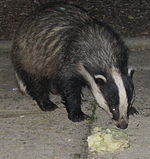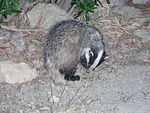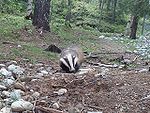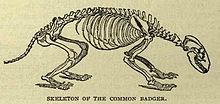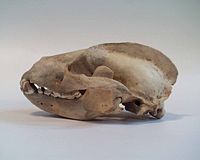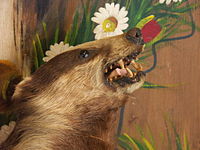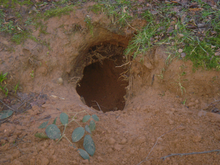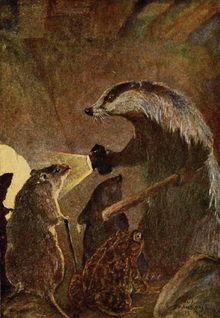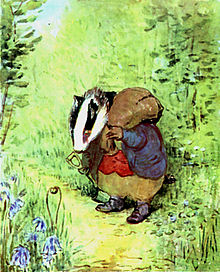- European badger
-
European Badger
Temporal range: Mid-Pleistocene–Recent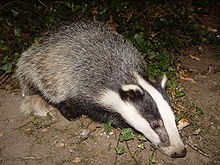
Conservation status Scientific classification Kingdom: Animalia Phylum: Chordata Class: Mammalia Order: Carnivora Family: Mustelidae Genus: Meles Species: M. meles Binomial name Meles meles
(Linnaeus, 1758)
European Badger range The European Badger (Meles meles) is a species of badger of the genus Meles, native to almost all of Europe. It is classed as Least Concern for extinction by the IUCN, due to its wide distribution and large population.
The European badger is a social burrowing animal which lives on a wide variety of plant and animal food. It is very fussy over the cleanliness of its burrow, and defecates in latrines. Cases are known of European badgers burying their dead family members. Although ferocious when provoked, a trait which was once exploited for the blood sport of badger-baiting, the European badger is generally a peaceful animal, having been known to share its burrows with other species such as rabbits, red foxes and raccoon dogs. Although it does not usually prey on domestic stock, the species is nonetheless alleged to damage livestock through spreading bovine tuberculosis.
Contents
Nomenclature
Up until the mid-18th century, European badgers were variously known in Britain as brock, pate, grey and bawson. "Brock" still persists in some areas, the root word likely being the Danish word "brok", which also means badger. For example, in Irish Gaelic, the word for badger is broc. The name "bawson" is derived from "bawsened", which refers to something striped with white. "Pate" is a local name which was once popular in northern England. The name "badget" was once common, but restricted to Norfolk, while "earth dog" was used in Southern Ireland.[2]
Origin
The species likely evolved from the Chinese Meles thorali of the early Pleistocene. The modern species originated during the early Middle Pleistocene, with fossil sites occurring in Episcopia, Grombasek, Süssenborn, Hundsheim, Erpfingen, Koneprusy, Mosbach 2, Stránská Skála. A comparison between fossil and living specimens shows a marked progressive adaptation to omnivory, namely in the increase in the molar's surface area and the modification of the carnassials. Occasionally, badger bones may be discovered in strata from much earlier dates, due to the species' burrowing habits.[3][4]
Subspecies
As of 2005[update],[5] eight subspecies are recognised.
Subspecies Trinomial authority Description Range Synonyms Common badger
Meles meles melesLinnaeus, 1758 A large subspecies with a strongly developed sagittal crest, a soft pelage and relatively dense underfur. The back has a relatively pure silvery-grey tone, while the main tone of the head is pure white. The dark stripes are wide and black, while the white fields fully extend along the upper and lateral parts of the neck. It can weigh up to 20–24 kg in autumn, with some specimens attaining even larger sizes[6] All Europe, save for Rhodes, Crete and Spain. Its eastern range encompasses the European area of the former Soviet Union eastward to the Volga, Crimea, Ciscaucasia, and the northern Caucasus alba (Gmelin, 1788)
britannicus (Satunin, 1905)
caninus (Billberg, 1827)
caucasicus (Ognev, 1926)
communis (Billberg, 1827)
danicus (Degerbøl, 1933)
europaeus (Desmarest, 1816)
maculata (Gmelin, 1788)
tauricus (Ognev, 1926)
taxus (Boddaert, 1785)
typicus (Barrett-Hamilton, 1899)
vulgaris (Tiedemann, 1808)Cretan badger
Meles meles arcalusMiller, 1907 Crete Trans-Caucasian badger
Meles meles canascensBlanford, 1875 A small subspecies with a dirty-greyish back with brown highlights. The head is identical to Meles m. meles, though with weaker crests, and its upper molars are elongated in a similar way to the Asian badger[7] Transcaucasia, Kopet Dag, Turkmenia, Iran, Afghanistan and possibly Asia Minor minor (Satunin, 1905)
ponticus (Blackler, 1916)
Kizlyar badger
Meles meles heptneriOgnev, 1931 A large subspecies exhibiting several traits of the Asian badger, namely its very pale, dull, dirty-greyish-ocherous colour and narrow head stripes[7] Steppe region of northeastern Ciscaucasia, the Kalmytsk steppes and the Volga delta Iberian badger
Meles meles marianensisGraells, 1897 Iberian Peninsula mediterraneous (Barrett-Hamilton, 1899) Norwegian badger
Meles meles milleriBaryshnikov, Puzachenko and Abramov, 2003 A small subspecies South-west Norway Rhodes badger
Meles meles rhodiusFesta, 1914 Rhodes Fergana badger
Meles meles severzoviHeptner, 1940 A small subspecies with a relatively pure, silvery-grey back with no yellow sheen. The head stripes are wide and occupy the whole ear. Its skull exhibits several features which are transitory between the Asian and European badger[7] Right tributary region of the Panj River, the upper Amu Darya, Pamiro-Alay system, the Fergana Valley and its adjoining southern and mountains bokharensis (Petrov,1953) Physical description
Build
European badgers are powerfully built animals with small heads, thick, short necks, stocky wedge-shaped bodies and short tails. Their feet are digitigrade and short, with five toes on each foot.[8] The limbs are short and massive, with naked lower surfaces on the feet. The claws are strong, elongated and have an obtuse end, which assists in digging.[9] The claws are non-retractable, and the hind claws wear with age. Old badgers are sometimes found with their hind claws nearly completely worn away from constant digging.[10] Their snouts, which are used for digging and probing, are muscular and flexible. The eyes are small and the ears short and tipped with white. Whiskers are present on the snout and above the eyes. Boars typically have broader heads, thicker necks and relatively pointed and narrow tails than sows, which are sleeker, have narrower, less domed heads and fluffier tails. Their guts are longer than those of red foxes. The small intestine has a mean length of 5.36 metres, and lacks a cecum. Both sexes have three pairs of nipples, which are more developed in females.[8] European badgers cannot flex their backs as martens, polecats and wolverines can, nor can they stand fully erect like honey badgers, though they can move quickly at full gallop.[9] Adults measure 25-30 cm (10-12 in) in shoulder height,[11] 60–90 cm (24-36 in) in body length, 12–24 cm (4.7-9.5 in) in tail length, 7.5–13 cm (3-5 in) in hind foot length and 3.5–7 cm (1.4-2.8 in) in ear height. Males (or boars) slightly exceed females (or sows) in measurements but can weigh considerably more. Their weight varies seasonally, growing from spring to autumn and reaches a peak during the onset of hibernation. During the summer, they weigh 7–13 kg (15-27 lb) and 15–17 kg (33-38 lb) in autumn. Sows can attain a top weight of around 17.2 kg (38 lb) while exceptionally large boars have been reported in autumn. The heaviest verified was 27.2 kg (60 lb), though unverified specimens have been reported to 30.8 kg (68 lb).[12][13] Although their sense of smell is acute, their eyesight is monochromatic, as they have been known not to react to red lanterns. Only moving objects attract their attention. Their hearing is no higher than that of humans.[14]
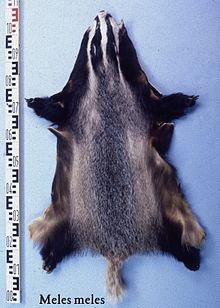 Badger skin. The contrasting markings of the fur serve to warn off attackers rather than camouflage, as they are conspicuous at night[15]
Badger skin. The contrasting markings of the fur serve to warn off attackers rather than camouflage, as they are conspicuous at night[15]
European badger skulls are quite massive, heavy and elongated. Their braincases are oval in outline, while the facial part of their skulls is elongated and narrow.[16] Adults have prominent sagittal crests which can reach 15 mm tall in old males,[17] and are more strongly developed than those of honey badgers.[18] Aside from anchoring the jaw muscles, the thickness of the crest protects the skull from hard blows.[19] Similarly to martens,[20] the dentition of European badgers is well suited for their omnivorous diet. Their incisors are small and chisel-shaped, their canine teeth are prominent and their carnassials are not overly specialised. Their molars are flattened and adapted for grinding.[17] Their jaws are powerful enough to crush most bones ; there is one record of a provoked badger biting down on a man's wrist so severely that it had to be amputated.[21] The dental formula is:
Dentition 3.1.3.3 3.1.4.2 Scent glands are present below the base of the tail and on the anus. The subcaudal gland secretes a musky smelling cream coloured fatty substance, while the anal glands secrete a stronger smelling yellowish-brown fluid.[17]
Fur
In winter, the fur on the back and flanks is long and coarse, consisting of coarse and bristly guard hairs with a sparse, soft undercoat. The belly fur consists of short, sparse hairs, with skin being visible in the inguinal region. Guard hair length on the middle of the back is 75–80 mm in winter. Prior to hibernation, the throat, lower neck, chest and legs are black. The belly is of a lighter, brownish tint, while the inguinal region is brownish grey. The general colour of the back and sides is light silvery-grey, with straw coloured highlights on the sides. The tail has long and coarse hairs, and is generally the same colour as the back. Two black bands pass along the head, starting from the upper lip and passing upwards to the whole base of the ears. The bands sometimes extend along the neck and merge with the colour of the upper body. The front parts of the bands are 15 mm, and widen to 45–55 mm in the ear region. A wide white band extends from the nose tip through the forehead and crown. White markings occur on the lower part of the head, and extend backwards to a great part of the neck's length. The summer fur is much coarser, shorter and sparser, and is much darker in colour, with the black tones becoming brownish and the yellowish tinges.[9] Partial melanism in badgers is known, and albinos are not uncommon. Albino badgers can be pure white or yellowish with pink eyes. Erythristic badgers are more common than the former, being characterised by having a sandy-red colour on the usually black parts of the body. Yellow badgers are also known.[22]
Behaviour
Social and territorial behaviours
European badgers are the most social of badgers,[23] forming groups of six adults on average, though groups of 23 are known. Group size may be related to habitat composition. In optimal habitat, badger territories can be as small as 30 ha, and large as 150 ha in marginal areas. Badger territories can be identified by the presence of communal latrines and well worn paths. There is little evidence of a dominance hierarchy, with animals within and outside a group showing considerable tolerance of each other. Boars tend to mark their territories more actively than sows, with their territorial activity increasing during the mating season in early spring.[24] Badgers groom each other very thoroughly with their claws and teeth. Grooming may have a social function.[25] They are crepuscular and nocturnal in habits.[25] Aggression among badgers is largely associated with territorial defence and mating. When fighting, badgers bite each other on the neck and rump, while running and chasing. Injuries incurred in such fights can be severe and sometimes fatal.[26] When attacked by dogs or sexually excited, badgers may raise their tails and fluff up their bodies. European badgers have a high vocal repertoire; when threatened, they emit deep growls. They bark when surprised, and whicker when playing or are distressed. When fighting, they emit low kekkering noises.[26]
Reproduction and development
Estrus in European badgers lasts 4–6 days, and may occur throughout the year, though there is a peak in spring. Sexual maturity in boars occurs in varying periods ; on average, it is attained at the age of 12–15 months, while in others it is attained as early as 8–9 months or as late as two years. They are normally fecund during January–May, with spermatogenesis declining in summer. Sows usually begin ovulating in their second year, though some exceptionally begin at 9 months. They can mate at any time of the year, though the main peak occurs in February–May, when mature sows are in postpartal estrus and young animals experience their first estrus. Matings occurring outside this period typically occurs in sows which either failed to mate early or matured slowly.[27] Badgers are usually monogamous ; boars typically mate with one female for life, whereas sows have been known to mate with more than one male.[28] Mating lasts 15–60 minutes, though they may briefly copulate for 2 minutes when the sow is not in estrus. There is a 2-9 month period of delayed implantation before the fertilised eggs implant into the uterus' walls, though matings in December can result in immediate implantation. Ordinarily, implantation happens in December, with a gestation period lasting seven weeks. Cubs are usually born in mid-January or mid-March within underground chambers containing bedding. In areas where the countryside is waterlogged, cubs may be born above ground in buildings. Typically, only dominant sows can breed, as they suppress the reproduction of subordinate females.[27]
The average litter consists of 1-5 cubs.[27] Although many cubs are sired by resident males, up to 54% can be fathered by boars from different groups.[24] Dominant sows may kill the cubs of subordinates.[26] Cubs are born pink, with greyish, silvery fur and fused eyelids. Neonatal badgers are 12 cm in body length on average and weigh 75-132 grams, with cubs from large litters being smaller.[27] By 3–5 days, their claws become pigmented, and individual dark hairs begin to appear.[28] Their eyes open at five days of age, and their milk teeth erupt after 4–6 weeks. They emerge from their setts at 8 weeks of age, and begin to be weaned at 12 weeks, though they may still suckle until they are 4–5 months old. Subordinate females assist the mother in guarding, feeding and grooming the cubs.[27] Cubs fully develop their adult coat at 41–68 days.[28] In areas with medium-high badger populations, dispersal from the natal group is uncommon, though badgers may temporarily visit other groups.[25]
Denning behaviours
Like other badger species, European badgers are burrowing animals. However, the dens constructed by European badgers (called setts) are the most complex, and are passed on from generation to generation.[29] The number of exits in one sett can fluctuate from 1-2 to 44-50. The underground constructions of badgers can be vast, and can sometimes accommodate multiple families. In the latter case, several isolated passages and nesting chambers occur. Some setts may have exits which are only used in times of danger or play. A typical sett has a 22–63 cm wide base and a 14–32 cm height. Three nesting chambers occur in setts, some of which are open both ends. The nesting chamber is located 5–10 metres from the opening, and is situated more than a metre underground, in some cases 2.3 metres. Generally, the passages are 35–81 metres long. The nesting chamber is on average 74 x 76 cm, and are 38 cm high.[30] Badgers dig and collect bedding throughout the year, particularly in autumn and spring. Sett maintenance is usually carried out by subordinate sows and dominant boars. The sett chambers are frequently lined with bedding, which is brought in on dry nights, consisting of grass, bracken, straw, leaves or moss. Up to 20-30 bundles can be carried to the sett on a single night. They are fastidiously clean animals, which regularly discard old bedding. During the winter, they may take their bedding outside on sunny mornings and retrieve it later.[24] Spring cleaning is connected to the birth of cubs, and may occur several times during the summer to prevent parasite infestations.[30] If a badger dies within a sett chamber, its conspecifics will seal off the chamber and dig a new one. Some badgers will drag their dead out of the sett and bury them outside.[31] A sett is almost invariably located near a tree, which is used by badgers for stretching or claw scraping.[32] Badgers defecate in latrines, which are located near the sett and at strategic locations on territorial boundraries or near places with abundant food.[25] In extreme cases, when there is a lack of suitable burrowing grounds, badgers will move into haystacks in winter.[30] They may share their earths with red foxes or European rabbits. Rabbits may benefit from the presence of badgers as protection against other predators, and usually avoid predation from the badgers themselves by burrowing in smaller, hard to reach chambers.[33]
Winter sleep
As with bears, winter sleep in badgers is not accompanied by the lowering of body temperature or bodily functions. Badgers begin to prepare for winter sleep during late summer by accumulating fat reserves, which reach a peak in October. During this period, the sett is cleaned and the nesting chamber filled with bedding. They typically stop leaving their setts once snow falls. In Russia, badgers retire for their winter sleep from late October to mid-November. In areas such as England and Transcaucasia, where winters are less harsh, badgers either forgo winter sleep entirely or do so with repeated interruptions. Upon retiring to sleep, badgers block their sett entrances with dry leaves and earth. They emerge from their setts in March and early April.[14]
Diet
Along with brown bears, European badgers are among the least carnivorous members of the Carnivora ;[34] they are highly adaptable and opportunistic omnivores, whose diet encompasses a wide range of animals and plants. Earthworms are their most important food source, followed by large insects, small or young mammals, carrion, cereals, fruit and underground storage organs. Mammals preyed on by badgers include rabbits, rats, mice, voles, shrews, moles and hedgehogs. Insect prey includes chafers, dung and ground beetles, caterpillars, leatherjackets, and the nests of wasps and bumblebees. Cereal food includes wheat, oats, maize and occasionally barley. Fruits include windfall apples, pears, plums, blackberries, bilberries, raspberries, strawberries, acorns, beechmast, pignuts and wild arum corms. Occasionally, they feed on ground nesting and roosting birds, frogs, toads, newts, snakes, lizards, snails, slugs, fungi, and green food such as clover and grass, particularly in winter and during droughts.[25] Badgers characteristically capture large numbers of one food type in each hunt. Generally, they do not eat more than 0.5 kg of food per day, with young specimens yet to attain one year of age eating more than adults. An adult badger weighing 15 kg eats a quantity of food equal to 3.4% of its body weight.[34] Badgers typically eat prey on the spot, and rarely transport it to their setts. Surplus killing has been observed in chicken coops.[25]
Badgers prey on rabbits throughout the year, especially during times when their young are available. They catch young rabbits by locating their position in their nest by scent, then dig vertically downwards to the nest. In mountainous or hilly districts, where vegetable food is scarce, badgers rely on rabbits as a principal food source. Adult rabbits are usually avoided, unless they are wounded or caught in traps.[35] They consume rabbits by turning them inside out and eat the meat, leaving the inverted skin uneaten.[36] Hedgehogs are eaten in a similar manner.[35] In areas where badgers are common, hedgehogs are scarce.[23] Some rogue badgers may kill lambs, though this is very rare. Badgers may be erroneously implicated in lamb killings through the presence of discarded wool and bones near their setts, though foxes, which occasionally live alongside badgers, are often the culprits, as badgers do not transport food to their earths. They typically kill lambs by biting them behind the shoulder. Poultry and game birds are also taken only rarely. Some badgers may build their setts in close proximity to poultry or game farms without ever causing damage. In the rare instances in which badgers do kill reared birds, the killings usually occur in February–March, when food is scarce due to harsh weather and increases in badger populations. Badgers can easily breach bee hives with their jaws, and are mostly indifferent to bee stings, even when set upon by swarms.[35]
Relationships with other predators
European badgers have few natural enemies. Wolves, lynxes and dogs can pose a threat to badgers, though deaths caused by them are rare. They may live alongside red foxes in isolated sections of large burrows.[31] It is possible that the two species tolerate each other out of commensalism ; foxes provide badgers with food scraps, while badgers maintain the shared burrow's cleanliness.[37] However, cases are known of badgers driving vixens from their dens and destroying their litters without eating them.[31] Raccoon dogs may extensively use badger setts for shelter. There are many known cases of badgers and raccoon dogs wintering in the same hole, possibly because badgers enter hibernation 2 weeks earlier than the latter, and leave 2 weeks later. In exceptional cases, badger and raccoon dog cubs may coexist in the same burrow. Badgers may drive out or kill raccoon dogs if they overstay their welcome.[38]
Range
The distributional boundrary between the ranges of European and Asian badgers is the Volga River, the European species being situated on the western bank. They are common in European Russia, with 30,000 individuals having been recorded there in 1990. They are abundant and increasing throughout their range due to a reduction in rabies. In the UK, badgers experienced a 77% increase in population during the 1980s-1990s.[1] The current badger population in Great Britain is estimated at 250,000 (190,000 in England, 25,000 in Scotland and 35,000 in Wales).[27]
Diseases and parasites
Tuberculosis is a major mortality factor in badgers, though infected badgers can live and successfully breed for years before succumbing. Badgers are vulnerable to the mustelid herpesvirus-1, as well as rabies and canine distemper, though the latter two are absent in Great Britain. Badgers have been implicated in spreading bovine tuberculosis to cattle. Other diseases carried by European badgers include arteriosclerosis, pneumonia, pleurisy, nephritis, enteritis, polyarthritis and lymphosarcoma. Ectoparasites carried by badgers include the fleas Paraceras melis, Chaetopsylla trichosa and Pulex irritans, the lice Trichodectes melis, the ticks Ixodes ricinus, I. canisuga, I. hexagonus, I. reduvius, I. melicula. Mange is also carried by them. Helminths carried by badgers include trematodes such as Itygonimus lorum, nematodes such as Molineus patens, Uncinaria stenocephala, Capilara erinacei, Aelurostrongylus falciformis and tapeworms such as Mesocestoides lineatus and Dilepis undula.[39]
Relationships with humans
In folklore and literature
Mr. Badger, as portrayed in an illustrated edition of Kenneth Graham's The Wind in the Willows
In Irish mythology, badgers are portrayed as shape-shifters and kinsmen to Tadg, the king of Tara and foster father of Cormac mac Airt. In one story, Tadg berates his adopted son for having killed and prepared some badgers for dinner.[40] In German folklore, the badger is portrayed as a cautious, peace-loving Philistine, who loves more than anything his home, family and comfort, though he can become aggressive if surprised. He is a cousin of Reynard the Fox, whom he uselessly tries to convince to return to the path of righteousness.[2]
In Kenneth Graham's The Wind in the Willows, Mr. Badger is depicted as a gruff, solitary figure who "simply hates society", yet is a good friend to Mole and Ratty. A friend of Toad's now-deceased father, he is often firm and serious with Toad, but at the same time generally patient and well-meaning towards him. He can be seen as a wise hermit, a good leader and gentleman, embodying common sense. He is also brave and a skilled fighter, and helps clear the Wild Wooders from Toad Hall. A villainous badger named Tommy Brock appears in Beatrix Potter's 1912 book The Tale of Mr. Tod, where he is shown kidnapping the children of Benjamin Bunny and his wife Flopsy, and hides them in an oven in the home of Mr. Tod the fox, with whom he fights in the book's conclusion. The book's portrayal of the badger as a filthy animal which appropriates fox dens was criticised from a naturalistic viewpoint, though the inconsistencies are few and employed to create individual characters rather than evoke an archetypical fox and badger.[41] A wise old badger named Trufflehunter appears in C. S. Lewis' Prince Caspian, where he aids Caspian X in his struggle against King Miraz. A badger takes a prominent role in Colin Dann's The Animals of Farthing Wood series as second in command to Fox. The badger is also the house symbol for Hufflepuff in the "Harry Potter" book series. The Redwall series also has the Badger Lords, who rule the extinct volcano fortress of Salamandastron and are renowned as fierce warriors.
Hunting
European badgers are of little significance to hunting economies, though they may be actively hunted locally. Methods used for hunting badgers include catching them in jaw traps, ambushing them at their setts with guns, smoking them out of their earths and through the use of specially bred dogs such as fox terriers and dachshunds to dig them out.[42] Badgers are however notoriously durable animals ; their skin is thick, loose and covered in long hair which acts as protection, and their heavily ossified skulls allow them to shrug off most blunt traumas, as well as shotgun pellets.[43]
Some badger products have medicinal properties ; badger expert Ernest Neal, quoting from an 1810 edition of The Sporting Magazine, wrote ;
'The flesh, blood and grease of the badger are very useful for oils, ointments, salves and powders, for shortness of breath, the cough of the lungs, for the stone, sprained sinews, collachs etc. The skin being well dressed is very warm and comfortable for ancient people who are troubled with paralytic disorders.'
—[44]
Their hairs are used for making shaving brushes and sporrans[44] and the skin is sometimes used to make shagreen. Badger meat is eaten in some districts of the former Soviet Union, though in most cases it is discarded.[42] Smoked hams made from badgers were once highly esteemed in England, Wales and Ireland.[44]
Badger-baiting
Main article: Badger-baitingBadger-baiting was once a popular blood sport, in which badgers were captured alive, placed in boxes and forced to fight dogs.
Badger baiting was outlawed in the United Kingdom as early as 1835, with the Cruelty to Animals Act. The practice of baiting of animals is now specifically forbidden under the Protection of Animals Act 1911.[45] Moreover, the cruelty towards and death of the badger constitute offences under the Protection of Badgers Act 1992, and further offences under this act are inevitably committed to facilitate badger baiting (such as interfering with a sett, or the taking or the very possession of a badger for purposes other than nursing an injured animal to health). If convicted, badger baiters may face a sentence of up to 6 months in jail, a fine of up to £5000, as well as other punitive measures, such as community service or a ban from owning dogs.[46]
Tameability
There are several accounts of European badgers being tamed. Tame badgers can be affectionate pets, and can be trained to come to their owners when their names are called. They are easily fed, as they are not fussy eaters, and will instinctively unearth rats, moles and young rabbits without training, though they do have a weakness for pork. Although there is one record of a tame badger befriending a fox, they generally do not tolerate the presence of cats and dogs, and will chase them.[47]
References
Notes
- ^ a b Kranz, A., Tikhonov, A., Conroy, J., Cavallini, P., Herrero, J., Stubbe, M., Maran, T., Fernades, M., Abramov, A. & Wozencraft, C. (2008). Meles meles. In: IUCN 2008. IUCN Red List of Threatened Species. Downloaded on 21 March 2009. Database entry includes a brief justification of why this species is of least concern
- ^ a b Neal 1958, pp. 150–152
- ^ Kurtén 1968, pp. 103–105
- ^ Spagnesi & De Marina Marinis 2002, pp. 226–227
- ^ Wozencraft, W. Christopher (16 November 2005). "Order Carnivora (pp. 532-628)". In Wilson, Don E., and Reeder, DeeAnn M., eds. Mammal Species of the World: A Taxonomic and Geographic Reference (3rd ed.). Baltimore: Johns Hopkins University Press, 2 vols. (2142 pp.). ISBN 978-0-8018-8221-0. OCLC 62265494. http://www.bucknell.edu/msw3/browse.asp?id=14001283.
- ^ Heptner & Sludskii 2002, pp. 1253–1254
- ^ a b c Heptner & Sludskii 2002, pp. 1254–1255
- ^ a b Harris & Yalden 2008, p. 427
- ^ a b c Heptner & Sludskii 2002, pp. 1234–1237
- ^ Neal 1958, p. 23
- ^ Pease 1898, p. 24
- ^ Wood, The Guinness Book of Animal Facts and Feats. Sterling Pub Co Inc (1983), ISBN 978-0851122359
- ^ Heptner & Sludskii 2002, pp. 1241–1242
- ^ a b Heptner & Sludskii 2002, p. 1272
- ^ Neal 1958, p. 25
- ^ Heptner & Sludskii 2002, p. 1238
- ^ a b c Harris & Yalden 2008, p. 428
- ^ Heptner & Sludskii 2002, p. 1214
- ^ Neal 1958, p. 29
- ^ Pease 1898, p. 29
- ^ Pease 1898, p. 35
- ^ Neal 1958, p. 27
- ^ a b Macdonald 2001, p. 117
- ^ a b c Harris & Yalden 2008, pp. 430–431
- ^ a b c d e f Harris & Yalden 2008, p. 432
- ^ a b c Harris & Yalden 2008, p. 431
- ^ a b c d e f Harris & Yalden 2008, pp. 433–434
- ^ a b c Heptner & Sludskii 2002, pp. 1278–1279
- ^ Macdonald 2001, p. 116
- ^ a b c Heptner & Sludskii 2002, pp. 1269–1272
- ^ a b c Heptner & Sludskii 2002, pp. 1279–1281
- ^ Neal 1958, p. 83
- ^ Pease 1898, p. 45
- ^ a b Heptner & Sludskii 2002, pp. 1265–1268
- ^ a b c Neal 1958, pp. 70–80
- ^ Pease 1898, p. 62
- ^ Dale, Thomas Francis, The fox, Longmans, Green, and Co., 1906
- ^ Heptner, V. G. ; Naumov, N. P., Mammals of the Soviet Union Vol.II Part 1a, SIRENIA AND CARNIVORA (Sea cows; Wolves and Bears), p. 107, Science Publishers, Inc. USA. 1998, ISBN 1886106819
- ^ Harris & Yalden 2008, p. 435
- ^ Monaghan, Patricia, The encyclopedia of Celtic mythology and folklore, p.436, Infobase Publishing, 2004, ISBN 0816045240
- ^ MacDonald, Ruth K., Beatrix Potter, p.47, Twayne Publishers, 1986, ISBN 0-8057-6917-X
- ^ a b Heptner & Sludskii 2002, pp. 1281–1282
- ^ Pease 1898, p. 36
- ^ a b c Neal 1958, pp. 152–154
- ^ "Protection of Animals Act 1911 (revised)". OPSI website. http://www.opsi.gov.uk/RevisedStatutes/Acts/ukpga/1911/cukpga_19110027_en_1. Retrieved 2009-06-16.
- ^ "Protection of Badgers Act 1992". OPSI website. http://www.opsi.gov.uk/ACTS/acts1992/ukpga_19920051_en_1. Retrieved 2009-06-16.
- ^ Pease 1898, pp. 58–61
Bibliography
- Harris, Stephen; Yalden, Derek (2008). Mammals of the British Isles. Mammal Society; 4th Revised edition edition. ISBN 0906282659
- Kurtén, Björn (1968). Pleistocene mammals of Europe. Weidenfeld and Nicolson
- Heptner, V. G.; Sludskii, A. A. (2002). Mammals of the Soviet Union. Vol. II, part 1b, Carnivores (Mustelidae and Procyonidae). Washington, D.C. : Smithsonian Institution Libraries and National Science Foundation. ISBN 90-04-08876-8. http://www.archive.org/details/mammalsofsov212001gept
- Macdonald, David (2001). The New Encyclopedia of Mammals. ISBN 0198508239
- Neal, Ernest (1958). The Badger. Penguin Books
- Pease, Alfred Edward (1898). The badger; a monograph. London : Lawrence and Bullen, ltd.. http://www.archive.org/details/badgermonograph00peasiala
- (Italian) Spagnesi, Mario; De Marina Marinis, Maria (2002). Mammiferi d'Italia. Quaderni di Conservazione della Natura. ISSN 15922901. http://www.minambiente.it/opencms/export/sites/default/archivio/biblioteca/protezione_natura/qcn_14.pdf
Further reading
- Ernest Neal & Chris Cheeseman. Badgers (Poyser, 2002)
- Richard Meyer. The Fate of the Badger (Batsford 1986)
External links
- ARKive Photographs and video
- The Badger Trust - representing over 80 British badger groups
- Steve Jackson's Badger Pages - Facts about and photos of the badgers of the world
- Badgerland - The Definitive On-Line Guide to Badgers (Meles meles) in the UK
- Badgerwatcher.com - A guide to watching badgers in the UK
- Wildlifeonline - Natural History of the European Badger
- Lancashire Badger Group.
- Science & Nature: Animals, BBC.
- Badgers in the Netherlands, Badgergroup Brabant Foundation.
- Badger Survey in the Netherlands 2000-2001, The Census Foundation.
- Waarneming.nl Originally a Dutch site, but you can change language at the top of the page. Sightings, pictures and distribution maps of European badgers in the Netherlands.
- Badgers in France, L’assiociation Meles.
- Badgers and TB in the UK
- DEFRA (UK government department) position on badgers and TB
- Executive summary of the Krebs Report Bovine Tuberculosis in Cattle and Badgers 1997
- The Randomised Badger Culling Trial
- Godfray Report, Independent Scientific Review of the Randomised Badger Culling Trial and Associated Epidemiological Research, March 2004. PDF format
- National Farmers Union proposals to control badgers (would involve repeal of the 1992 act) July 2005
- NFBG (now Badger Trust) response to the National Farmers Union proposals, August 2005
- Claims of continued badger-hunting in the UK
- Allegations of lamping (among other practices) were made in the appendix to the NFBG (now Badger Trust) response to the Krebs Report
Categories:- IUCN Red List least concern species
- Badgers
- Fauna of Iran
- Fauna of Ireland
- Mammals of the United Kingdom
- Mammals of Germany
- Mammals of Asia
- Mammals of Europe
- Megafauna of Eurasia
- Mammals of Hungary
- Mammals of Great Britain
- Animals described in 1758
Wikimedia Foundation. 2010.


